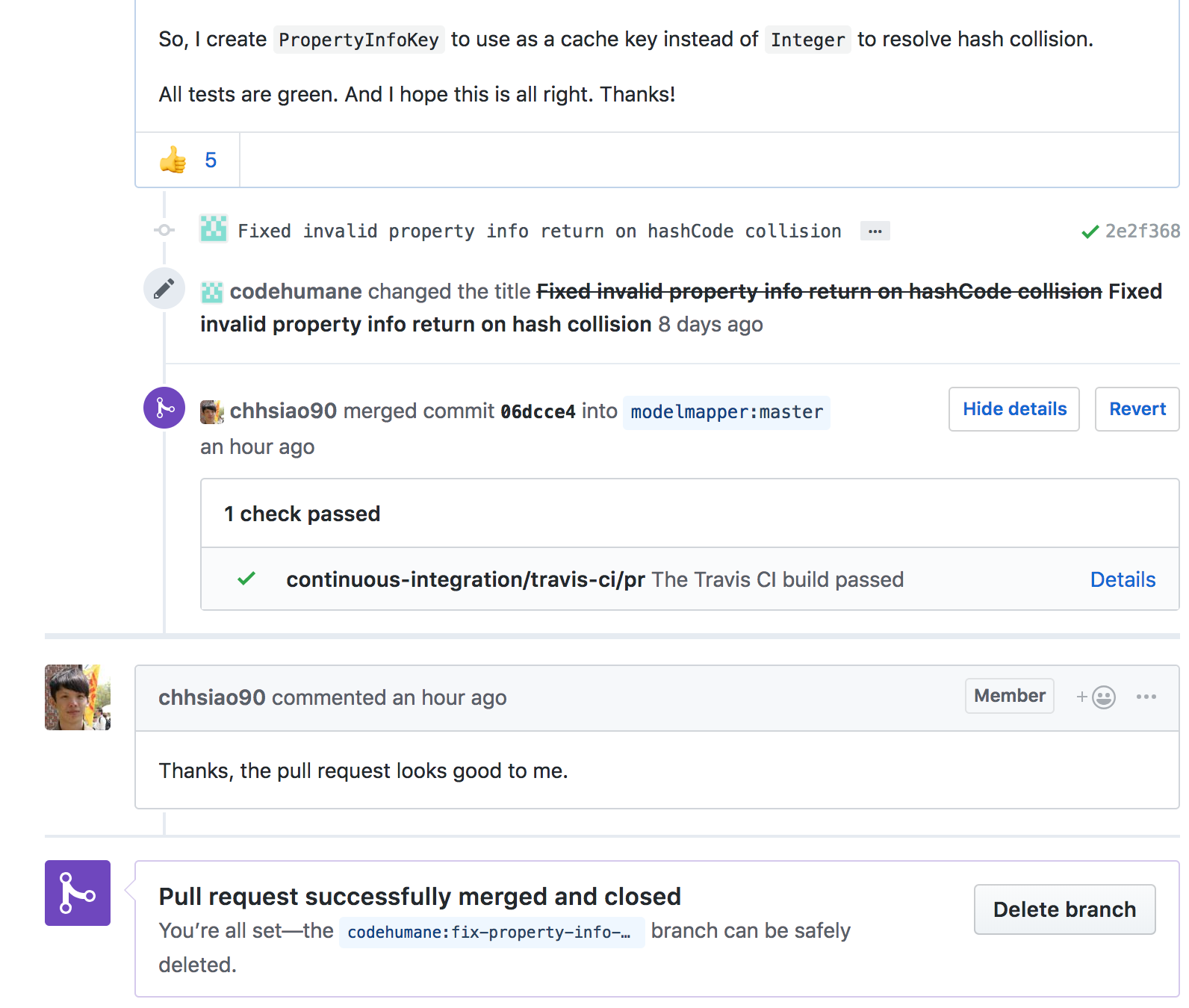ModelMapper 해시코드 충돌과 오픈 소스 기여
문제 상황
ModelMapper를 사용하는데 간헐적으로 아래와 같은 오류를 만남.
1) Error mapping ... (중략)
1 error
at org.modelmapper.internal.Errors.throwMappingExceptionIfErrorsExist(Errors.java:374)
at org.modelmapper.internal.MappingEngineImpl.map(MappingEngineImpl.java:69)
at org.modelmapper.ModelMapper.mapInternal(ModelMapper.java:529)
at org.modelmapper.ModelMapper.map(ModelMapper.java:372)
... (중략)
이 오류는 서비스 운영에 몇 가지 불편을 초래. 이 불편은 일시적인 것이 아니라 반복됐으며, 사용자에게도 영향을 미치는 일. 따라서 시간을 내서 해결해 보기로 함.
1차 대응 (코드 살피기)
처음엔 아래 2가지 문제 중 하나겠거니 생각.
- 동시성 이슈(synchronized 누락이나 CHM 사용 등)이거나,
- 캐시(모델매퍼는 성능상의 이슈로 매핑 정보를 로컬 캐싱)에 잘못된 데이터를 삽입.
-> 그러나, 코드를 한참 봐도 문제가 될 만한 부분 못 찾음. 실패.
2차 대응 (로그 남기기)
기존 에러 로그만으로는 충분히 문제를 찾기 어려워, 에러 발생시 문제라고 예상되는 지점을 추가로 로깅함. 바로, TypeMapStore의 typeMaps 필드. 그랬더니, 처음 예상했던 문제가 원인임을 발견. 캐시에 잘못 매핑된 데이터가 저장되어 있는 것.
예컨대, Source 클래스의 인스턴스를 Destination 타입으로 변환한다고 해보자. 두 클래스는 각각 name, age, sex, phone 속성을 가지고 있음. 이 때의 매핑 정보가 아래와 같은 식으로 되어 있는 것.
codehumane.Source -> codehumane.Destination
PropertyMapping[Source.name -> Destination.name]
PropertyMapping[Source.age -> Destination.age]
PropertyMapping[Hello.hi -> Destination.sex] // Source.age 대신 엉뚱한 정보가 들어 있다.
PropertyMapping[Source.phone -> Destination.phone]
3차 대응 (가성비 해결책 적용)
이 문제에 너무 오랜 시간을 쓸 수는 없으니, 아래의 꼼수를 생각.
- 캐시에 잘못된 데이터가 들어간 것이니,
- 문제가 발생하는 지점에
try catch를 넣고, ModelMapper인스턴스를 재생성하는 로직을 넣자.- 그럼 꼬여버린 캐시가 비워질 테고, 새로 쌓는 것과 같은 효과가 나지 않을까?
-> 하지만 실패. ModelMapper 인스턴스를 재생성 해도 문제는 곧바로 다시 발생함.
4차 대응 (근본적 문제 해결책 찾기)
그래서, source 클래스의 필드 정보를 어떻게 만드나 궁금해서 코드를 따라가 봄. 아래는 대략적인 코드의 호출 흐름.
ImplicitMappingBuilder#newTypeInfoImpl#getAccessorsPropertyInfoSetResolver.resolveAccessorsPropertyInfoResolver#propertyInfoForPropertyInfoRegistry.accessorFor
이 중에서 문제가 됐던 부분(다행히 금방 찾음)은 PropertyInfoRegistry.accessorFor. 코드를 보면 아래와 같음.
// 중략 ...
private static final Map<Integer, Accessor> ACCESSOR_CACHE = new ConcurrentHashMap<Integer, Accessor>();
// 중략 ...
static synchronized Accessor accessorFor(Class<?> type,
Method method,
Configuration configuration,
String name) {
Integer hashCode = hashCodeFor(type, name, configuration);
Accessor accessor = ACCESSOR_CACHE.get(hashCode);
if (accessor == null) {
accessor = new MethodAccessor(type, method, name);
ACCESSOR_CACHE.put(hashCode, accessor);
}
return accessor;
}
// 중략 ...
private static Integer hashCodeFor(Class<?> initialType,
String propertyName,
Configuration configuration) {
int result = 31 + initialType.hashCode();
result = 31 * result + propertyName.hashCode();
result = 31 * result + configuration.hashCode();
return result;
}
// ...
hashCodeFor의 결과는 중복될 수 있음. 그래서 저 값을 키로 사용하면, 키가 중복될 경우 값이 덮어 씌워질 위험이 있음. 간단히 코드를 작성해 보면 이를 확인할 수 있음.
@Test
public void hashCollision() {
val key1 = new Key("aaa");
val key2 = new Key("bbb");
val key1HashCode = key1.hashCode();
val key2HashCode = key2.hashCode();
/*
* hashCode 결과가 같은 Key 인스턴스를 키로 하여, 맵에 저장.
* 해시 충돌 해결이 잘 되는 경우
*/
val valid = new HashMap<Key, String>();
valid.put(key1, "AAA");
valid.put(key2, "BBB");
assertEquals("AAA", valid.get(key1));
assertEquals("BBB", valid.get(key2));
/*
* hashCode 결과를 키로 사용하는 경우.
* 값은 다른데, hashCode 결과는 얼마든지 같을 수 있음.
* 그런데도, 이걸 그대로 키로 사용하면 문제가 됨.
*/
val invalid = new HashMap<Integer, String>();
invalid.put(key1HashCode, "AAA");
invalid.put(key2HashCode, "BBB");
assertEquals("AAA", invalid.get(key1HashCode)); // 여기서 "BBB"가 반환됨
assertEquals("BBB", invalid.get(key2HashCode));
}
5차 대응 (문제의 코드 고치기)
Integer를 그대로 키로 쓰지 말고, 아래와 같이 하는 게 어땠을까.
@Getter
@RequiredArgsConstructor
class PropertyKey {
private final Class<?> initialType;
private final String propertyName;
private final Configuration configuration;
@Override
public boolean equals(Object o) {
if (this == o) return true;
if (o == null || getClass() != o.getClass()) return false;
PropertyKey that = (PropertyKey) o;
return Objects.equals(initialType, that.initialType) &&
Objects.equals(propertyName, that.propertyName) &&
Objects.equals(configuration, that.configuration);
}
@Override
public int hashCode() {
int result = 31 + initialType.hashCode();
result = 31 * result + propertyName.hashCode();
result = 31 * result + configuration.hashCode();
return result;
}
}
class PropertyInfoRegistry {
// 중략 ...
private static final Map<PropertyKey, Accessor> ACCESSOR_CACHE = new ConcurrentHashMap<>();
// 중략 ...
static synchronized Accessor accessorFor(Class<?> type,
Method method,
Configuration configuration,
String name) {
final PropertyKey key = new PropertyKey(type, name, configuration);
Accessor accessor = ACCESSOR_CACHE.get(key);
if (accessor == null) {
accessor = new MethodAccessor(type, method, name);
ACCESSOR_CACHE.put(key, accessor);
}
return accessor;
}
// 중략 ...
}
아래는 해시 충돌에 관한 Java API(Hashtable) 문서의 일부 설명.
in the case of a “hash collision”, a single bucket stores multiple entries, which must be searched sequentially
그리고 HashMap#get을 열어 보면 어떻게 동작하는지 어느 정도 알 수 있음.
public V get(Object key) {
Node<K,V> e;
return (e = getNode(hash(key), key)) == null ? null : e.value;
}
final Node<K,V> getNode(int hash, Object key) {
Node<K,V>[] tab; Node<K,V> first, e; int n; K k;
if ((tab = table) != null && (n = tab.length) > 0 &&
(first = tab[(n - 1) & hash]) != null) {
if (first.hash == hash && // always check first node
((k = first.key) == key || (key != null && key.equals(k))))
return first;
if ((e = first.next) != null) {
if (first instanceof TreeNode)
return ((TreeNode<K,V>)first).getTreeNode(hash, key);
do {
if (e.hash == hash &&
((k = e.key) == key || (key != null && key.equals(k))))
return e;
} while ((e = e.next) != null);
}
}
return null;
}
6차 대응 (라이브러리 GitHub 저장소에 PR 제출)
- 위에서 작성한 코드에 테스트 코드를 더하여 PR 제출.
- https://github.com/modelmapper/modelmapper/pull/438
- 그리고 머지 됨.

7차 대응 (테스트 환경에서의 검증)
- PR이 반영된 버전을 먼저 간단히 검토함. 변경 이력들도 살핌.
- 먼저, 테스트 환경에 적용. 그리고 수 개월 동안 모니터링.
- 문제가 없음을 확인하고 운영에 적용하기로 결정
8차 대응 (운영 적용)
- 배포 후에도 3개월간 문제가 없어야 한다를 완료의 정의로 잡음.
- 항상 문제가 발생하는 것은 아니기 때문.
- 다행히, 3개월은 물론, 지금까지도 문제 없음.
© 2020 codehumane ― Powered by Jekyll and Textlog theme